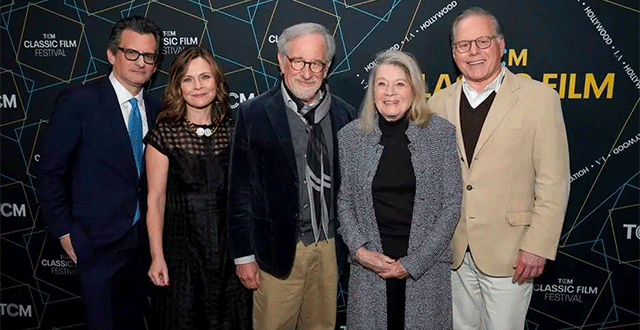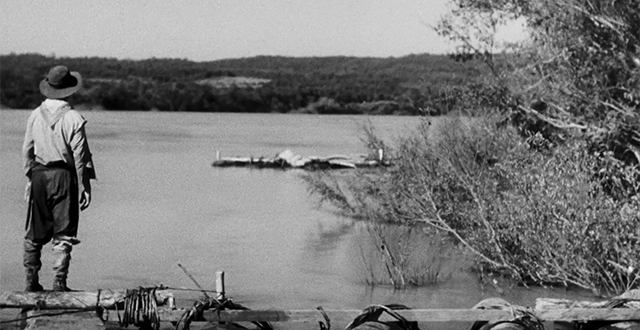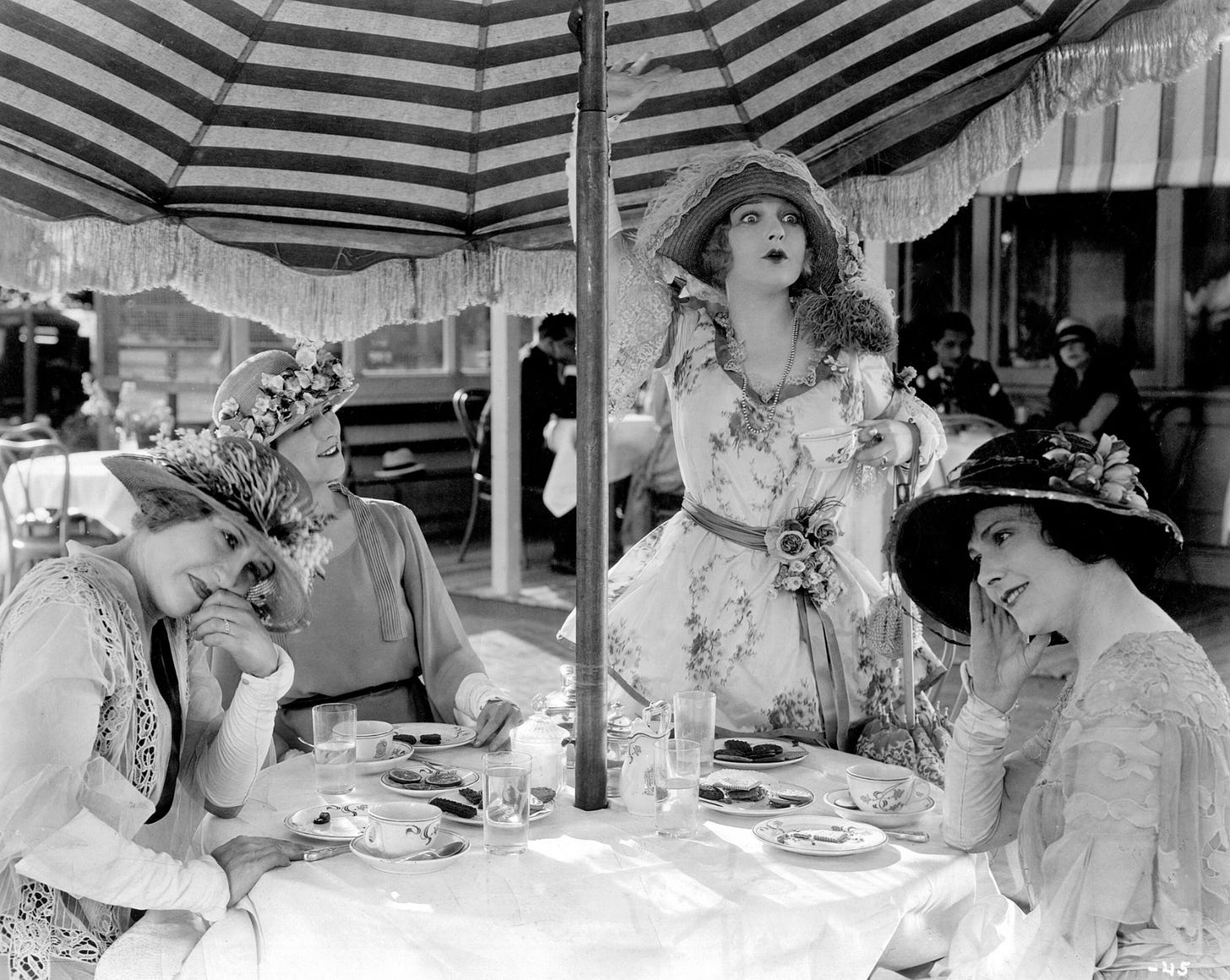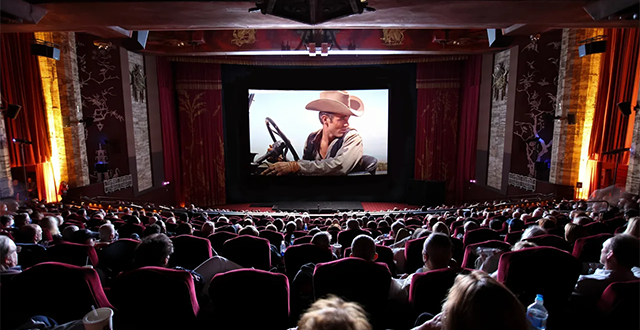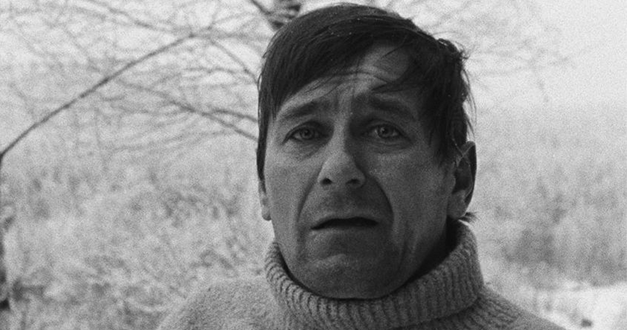News
TCM Classic Film Festival 2023: Hollywood Titans Support Saving Movie Memories
Anne Thompson
Opening night of the 14th TCM Classic Film Festival in Hollywood brought out not only the lustrous 4D restored Howard Hawks classic western “Rio Bravo” — starring John Wayne, Dean Martin, and Angie Dickinson, 91, who was on hand — but two directors and board members of Martin Scorsese’s Film Foundation, Steven Spielberg and Paul Thomas Anderson. They extolled Scorsese’s foresight and ongoing commitment to preserving and saving the original celluloid elements of classic films so that restorations like this one can occur.
“David and Warner Bros have their own archivists and they have titles they’d like from the Warner Bros. archive to be preserved,” said Spielberg explaining how titles are chosen, nearly 1000 since 1990 to date. “And every studio does have that but we try to find the films, not the films that are our favorite movies, but films that tell a very unique story of this country and the people of this country, and not only this country, but we’re rescuing experimental films, documentaries, already 97 international films. So this is something that’s not going to stop. And I just have to say I’m so proud that Marty [Scorsese], we’re all very busy making our movies, but in 1990 Marty put everything aside and said ‘no, this is what we were prioritizing. This is what needs to be done.’”
“It’s the preservation of our work,” Anderson added. “But it’s also preserving our memories and helping us to preserve those memories so that when you want to revisit that moment of that feeling of when you walked into a theater you can. We all want to hold on to our memories, but sometimes they fade away from us, but we can hold on to them if we preserve them this way.”
The other power mogul on the opening night panel moderated by TCM host Ben Mankiewicz was his boss, Warner Discovery CEO David Zaslav, who convincingly expressed his support of classic movies, especially from his studio, which made “Rio Bravo” back in 1959 and is now celebrating its 100th anniversary. “TCM is the history of our country,” he said, naming three Warners titles that made a crucial impact: anti-KKK film “Black Legion,” “Confessions of a Nazi Spy,” and “Gentleman’s Agreement.”
Zaslav could use some positive PR in the wake of this week’s announcements about switching over to revamped and renamed streaming service Max, which saw his company stock lose value on Wall Street. Lending public support to TCM and classic movies isn’t going to turn Warner Discovery’s fortunes around, but at least Zaslav appears to be on the side of the angels.

“Rio Bravo”
Courtesy Everett Collection
The opening night audience was packed with enthusiastic cinephiles, among them Harry Warner’s granddaughter Cass and Trailers from Hell contributor Allan Arkush cheering for Dickinson, who gamely submitted to questions from Mankiewicz, who cited “this shared feeling we all have, a sense of community we share, that has only intensified in the last 14 years.”
At age 27, Dickinson beat out the Hollywood ingenue audition competition, she said, with some help from director Hawks, who was looking for a comeback. As virtually the only woman on the production, did she hang out with the boys? “No,” she said. Wayne and Martin were too busy playing chess. While she calls Wayne’s character “John T.” in the movie, no one would ever call the massive western star John on set, she said. “We all called him Duke.”
Among the 100 events unfolding over the next week at the TCM Classic Movie Festival, George Clooney and Steven Soderbergh will host a Friday screening of “Oceans 11” as part of the Warners celebration, which includes screenings of ten studio movies including “Casablanca, “East of Eden,”” and “The Music Man.” Other celebrity hosts include Dana Delany (introducing RKO’s “Ball of Fire”) and TCM host Alicia Malone.
Restored Masterpiece From Argentina Screens Online This Weekend
Self-Styled Siren
If you are following the Siren, you’re probably very well aware of The Film Foundation, the film-preservation nonprofit founded by the Mighty Martin Scorsese in 1990. If not, you can read up on the Film Foundation’s mission here and also watch videos with Scorsese, Wes Anderson, and Ang Lee.
One of the Foundation’s more recent and wonderful projects is called The Restoration Screening Room—a virtual space to showcase preservation and restoration work. Each month they make a restored movie available online, free of charge, for 72 hours. This month’s offering is especially exciting because it’s so rare: the 1939 Argentine film Prisioneros de la Tierra, directed by Mario Soffici. According to the Foundation’s website, Prisioneros
…is considered one of the greatest films ever made in Argentina. Director Mario Soffici adapted four different short stories by Horacio Quiroga, the Uruguayan playwright, poet, and author, to craft a powerful and emotional film that examines issues of social justice through its myriad of characters, all human and all flawed. Set in the yerba mate plantations of northern Argentina, the film shows the harsh working conditions of the Guaraní Indians against the beautiful natural landscapes, which highlights the ongoing conflict between the upper and lower classes. Soffici effortlessly balances his social justice narrative with more melodramatic elements of love, betrayal, and alcoholism, all filmed in dramatic black-and-white, to create a rich and honest portrait of life's many struggles. In addition to its cinematic achievements, the film is also an important record of the Guaraní dialect, which is now virtually lost.
If you want to watch the movie, all you have to do is register. It will be available at that link as of 7 pm local time tonight. At the link, you can also watch Martin Scorsese’s personal introduction, as well as a conversation about Prisioneros between filmmakers Matías Piñeiro and Gina Telaroli, and another conversation with Paula Félix-Didier and Andrés Levinson of the Buenos Aires Film Museum. You can even join in a live screening with commentary on April 10, 2023 at 7pm EST.
I’ve been in a film-nerd tizzy about The Restoration Screening Room for months now, as it’s available to so many far-flung readers outside the New York area. This project spreads the word about the importance of film preservation in the best possible way: by showing people the movies.
I’ve even been able to participate myself. Back in December, the Film Foundation screened their gorgeous restoration of I’m No Angel, and I got to talk to Gina Telaroli about the movie and the inimitable Mae West. That restoration is no longer online, but if you want to see me chat with Gina, you still can at this link. I recommend clicking around and taking a look at the incredible materials that the Foundation still has up for past screenings such as Giant, The River, Sambizanga and La Strada.
And when you register, do check the box to get notifications about future events. Next month, the selection is Henry King’s 1925 silent Stella Dallas, starring Belle Bennett—the dazzling restoration from the Museum of Modern Art, of which Friend of the Siren Dave Kehr is justifiably proud. He screened it to a rapturous audience at Venice, and now here ‘tis!
How to help save film history
Julia Chan
It’s one of the most spectacular dance sequences ever captured on film: the Nicholas Brothers cutting loose on a double staircase in the classic musical Stormy Weather (1943).
“It would be terrible if a film like this was not around,” says Donald Bogle, the pioneering film historian of African American cinema and the recipient of this year’s Robert Osborne Award at the Turner Classic Movies Film Festival. (TCM and CNN are both subsidiaries of Warner Bros. Discovery.)
Unfortunately, many films from Stormy Weather’s era have not survived. Federal estimates suggest half of films made before 1950 and most before 1929 have deteriorated beyond repair or disappeared entirely.
“These movies, we don’t want to lose them,” Bogle says, “so preservation becomes very important. It’s part of our cultural history.”
This direct line to history underscores the power of cinema, says TCM General Manager Pola Chagnon. “I think the more that we as a culture can be connected not only to films of today but films of the past, we only gain empathy and understanding of what came before.”
Huge undertaking
Film restoration is expensive and time-consuming. According to The Film Foundation, digitally restoring a color feature with sound can cost up to several hundred thousand dollars. Even with multiple teams working simultaneously, restoration can take months, says Daphne Dentz, Senior Vice President of Emerging Formats, Mastering & Content Acquisition at Warner Bros.
Working with original camera negatives and audio, Dentz adds, “the aim of the restoration is to stay true to the content creator’s original creative intent.”
While the content stays the same, technology does not. That means once a film has been restored, the work is never really over.
“As the ways that people access these films change, films need preservation, and restoration is kind of an ongoing process,” says Margaret Bodde, The Film Foundation’s Executive Director. “The difference between something mastered for VHS and something mastered for Blu-ray is like night and day.”
“Since I’ve been here, The Wizard of Oz has been restored at least three times,” notes Dentz, who has worked at the studio 17 years. “This is something that is going to be a constant.”
Teaming up
With so many films in need of help, collaboration is vital. The Film Foundation, one of the leading organizations in film preservation, restoration, and education, works with studios, archives, and exhibitors. Board members from the non-profit also identify and suggest titles for prioritization, taking into account the film’s physical condition, historic, cultural, and artistic value, and whether it is the only surviving version.
In honor of Warner Bros.’ 100th anniversary, the foundation teamed up with the studio and TCM to restore Rio Bravo (1959), East of Eden (1955), One Way Passage (1932), and The Strawberry Blonde (1941) for the 2023 TCM Classic Film Festival. Board members like Steven Spielberg will appear at the event and on TCM air to talk about the importance of the restoration effort, and every film shown on TCM in April will be from the Warner Bros. library.
“It’s a terrific collaboration,” says Dentz, “because we all have the same ideas about how important it is to preserve these films culturally and to preserve these stories. These are stories that we want to be able to share with the world forever, if possible.”
How to support the cause
Whether you’re a casual moviegoer or a die-hard film buff, anyone can support film preservation and restoration.
“The main thing is to watch these movies,” says TCM General Manager Chagnon. “Try it. Give yourself license to be curious about other films.”
Bodde recommends seeing films in theaters and watching TCM. “It’s such a great way to celebrate and learn more about different filmmakers from the past and different films from around the world.”
Another way to support the cause: donating to non-profits committed to finding, restoring, and sharing classic films before it’s too late. Some of the major players in this space include:
American Film Institute
Academy Foundation
The Academy Foundation is the educational and cultural wing of the Academy of Motion Picture Arts and Sciences, the historic Hollywood organization behind the Academy Awards. Established in 1927 – the same year that saw (and heard) the first feature-length film with sound – the Academy began acquiring material for its archives in 1929, later launching the foundation in 1944 with sponsors such as Cary Grant and Howard Hawks. Today, the organization is home to the Academy Film Archive, one of the most extensive motion picture collections in the world; the Margaret Herrick Library, a research center focused on film history, craft, and industry; fellowships and educational programs; and the Academy Museum of Motion Pictures, a 300,000 square-foot facility devoted to film history and education that opened in 2021.
The Film Foundation
In 1990, a team of powerhouse filmmakers – Martin Scorsese, Woody Allen, Francis Ford Coppola, Stanley Kubrick, Sydney Pollack, Robert Redford, and Steven Spielberg – launched The Film Foundation to protect and preserve motion picture history for future generations. Scorsese still chairs the Directors Guild of America-affiliated organization, and since its founding, the non-profit has helped restore more than 950 films across every genre and era. The foundation has expanded its impact internationally with its World Cinema Project, and offers free virtual screenings every month through the Restoration Screening Room. The Film Foundation’s free educational initiative, The Story of Movies, has been featured in 45,000 schools across the U.S. and taught more than 10 million students.
Film Noir Foundation
Created by writer, film historian, and TCM host Eddie Muller in 2005, the Film Noir Foundation was born out of NOIR CITY, the annual Bay Area film festival devoted to the genre. The non-profit hosts screenings across the country and publishes a magazine to promote the “cultural, historical, and artistic significance of film noir as an international cinematic movement.” Proceeds are used to locate and restore genre films. The foundation has saved more than three dozen titles and offers a $5,000 grant for students focused on film restoration, preservation, or archiving.
National Film Preservation Foundation
After a federal report found fragile but historically significant motion pictures decaying faster than they could be saved, the film community teamed up with the Library of Congress in the 1990s to help Congress create the National Film Preservation Foundation. The NFPF began operating in 1997, issuing grants to archives, libraries, museums, and other organizations to help save the most at-risk material not included in commercial restoration projects, such as documentaries, silent-era films, home movies, and newsreels. The foundation has helped preserve more than 2,700 films across the country, with many available to view online, and partnered with international archives to restore American silent films discovered in their collections. NFPF’s federal funding goes directly to its preservation work so the organization relies on private donations and grants to keep it running.
UCLA Film & Television Archive
With more than 520,000 films, television shows, newsreels, and radio recordings, the University of California, Los Angeles’ Film & Television Archive houses one of the largest media collections in the country – second only to the Library of Congress. Founded in 1965, the archive collects, preserves and restores, screens, loans, and licenses archival moving images. A part of the university library system, the archive also operates the Archive Research and Study Center for the campus community and public.
‘Eight Deadly Shots’: A Finnish Film of Fierce Realism
Kristin M. Jones
Made for television in 1972, Mikko Niskanen’s four-part, five-hour work about moonshine-drenched desperation in a rural village is opening in a new restoration at New York’s Film Forum.
In the woods next to a gleaming lake, several men secretly drink moonshine, cook fish and sing songs by a fire in the waning light. It’s one of numerous vivid scenes involving illicit alcohol in “Eight Deadly Shots” (1972), a gripping miniseries by the Finnish actor and director Mikko Niskanen (1929-1990) about desperation and addiction in a rural community, and the events leading up to a shocking crime.
An important work in Finnish film history that deserves wider acclaim, “Eight Deadly Shots” was made for television and also later edited down for theatrical release. The original version, more than five hours long and in four parts, will screen at Film Forum in New York from March 31 to April 6 in a new 4K restoration by the Film Foundation’s World Cinema Project, Yleisradio Oy, Fiction Finland ry and Fondazione Cineteca di Bologna at L’Immagine Ritrovata laboratory. It will also screen at other U.S. venues, including the Cleveland Institute of Art Cinematheque in April and the American Cinematheque in Southern California in June.
Niskanen’s searing tale was inspired by the real-life killing of four police officers by a Finnish farmer, but it is grounded in memories of the rural area where the director was raised. A statement at the beginning of each episode reads in part, “Everyone may have his own truth, but this is the truth I saw and experienced, having been born into these surroundings, having lived this particular life, and having studied these matters.”
Summoning a fierce unity of vision, Niskanen directed, wrote and produced all four episodes, contributed some of the cinematography, and took on the demanding central role of a struggling farmer, Pasi. Tarja-Tuulikki Tarsala played Pasi’s wife, Vaimo, and Paavo Pentikäinen was Pasi’s friend Reiska, but the rest of the cast were nonprofessionals. The settings also convey a compelling realism.
Immediately evoking a powerful sense of place, the first episode opens with views of buildings, vegetation and trees filmed in what seems to be springtime from a vehicle driving on a road as children sing on the soundtrack. The sound of gunfire heralds a cut to the wintry murder scene, followed by glimpses of the funeral service for the victims, the anguished killer in a cell, and his wife and four children silent together at home. And then the film returns to a warmer season, with Pasi again a figure in a landscape holding a gun, but on a day when he shot a bird from a tall tree.

Mikko Niskanen and Paavo Pentikäinen
PHOTO: JANUS FILMS
Guns and alcohol are woven into the plot from the start. Pasi has been sneaking off to make moonshine with Reiska, telling his wife he is going hunting. As the seasons change and he and Vaimo struggle to provide for their family, he returns to drink for camaraderie and fleeting escape. Sometimes trying to outwit authorities seems like a boyishly defiant game, but he can’t elude arrests, fines, unpaid taxes and his own darker impulses.
Alcohol is a release from the sadness of underemployment, but also a family legacy, as Pasi’s father used to drink to excess. “You should stop the moonshining. Nothing good comes out of it,” Vaimo says to him in a moonlit scene in the first episode, when he has come home late. “Yes, I should move on to cognac,” he replies. Over time, his health suffers and marital strife becomes more disastrous. And yet there are moments of tenderness and humor, such as when the family celebrates Christmas by a tree glowing with candles and one of the boys plays Santa.
Scenes showing characters engaging in physical labor are as beautifully filmed as those in which men make and enjoy moonshine. Whether Pasi is energetically working the land or tackling odd jobs in harsh weather, such as logging or digging trenches for sewers, the camera takes in the grueling work and natural landscape like an intensely curious observer.

Tarja-Tuulikki Tarsala
PHOTO: JANUS FILMS
Niskanen’s writing and direction yielded a riveting story. His immersion into the part of Pasi—a character both ordinary and full of contradictions—makes it unforgettable. In Pasi’s most agonizing moments, such as after he drunkenly frightens his family, his face is a haunted mask. Near the end, his features keep slackening, he seems to terrifyingly fold into himself and his behavior is beyond easy explanation.
Playing the part took a physical toll. In a piece on “Eight Deadly Shots” for Film Comment magazine in 2012, the Finnish filmmaker and film historian Peter von Bagh, who made a documentary about Niskanen, wrote that the series was “wrought through friction and adversity, and it’s difficult to see it as anything but savagely independent filmmaking.”
In the second episode, Pasi, Vaimo and their children attend a wedding, an outing they prepare for with poignant anticipation, though Pasi will get drunk again. At this ostensibly hopeful gathering, glances exchanged in the crowd reflect social hierarchies and tensions. As the newlyweds waltz before a sea of faces, the bride reminds the groom that they have to dance, as if they could be Pasi and Vaimo’s younger selves. Out of many such small details, Niskanen built a devastating saga.
Ms. Jones writes about film and culture for the Journal.
Mikko Niskanen, “Eight Deadly Shots” (1972)
Film Forum, NY, 3/31–4/6
